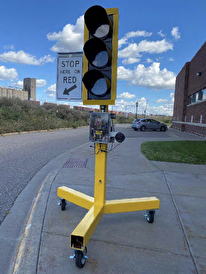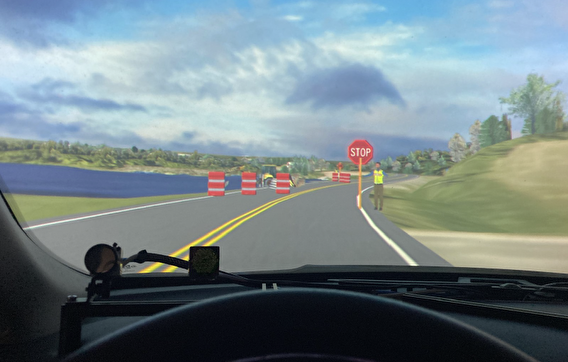
Work-zone traffic control is one of the country’s most dangerous jobs, and flaggers are often the first line of defense against distracted, inattentive, or aggressive motorists. U of M researchers are working to develop new, cost-effective “smart sign” technology to help make these jobs safer. The systems track the trajectory of vehicles approaching a work zone, alert drivers to slow or stop, and warn workers of an unsafe intrusion into the work zone.
While other digital smart signs for work zones have been developed, they’ve had varying levels of success due to operational complexities, cumbersome size, and prohibitive cost, says Nichole Morris, director of the Department of Mechanical Engineering’s HumanFIRST Laboratory and the project’s principal investigator. “Our goal was developing an affordable, portable intrusion detection system.”
The project was sponsored by the Minnesota Local Road Research Board. Professor Rajesh Rajamani of the Department of Mechanical Engineering was the co-investigator.
Researchers began by developing a proposed system that would meet their technical aims. These included accurate threat detection (to reduce risks of both missed detections and false alarms) and low cost (to afford greater opportunity to scale the system across multiple work zones and support a greater number of workers).

The original proposed design incorporated a low-cost sensor and processors on a modified Stop/Slow paddle. An audiovisual warning system activated when unsafe driving was identified, and a camera captured the event and vehicle information. Because of the unit’s weight (including the electronics and accompanying battery), it was mounted on a rolling platform.
Next, researchers initiated a worker-centered design process to identify worker needs and expectations of a safety system. Based on the feedback, the team redesigned the system as a modified, remote-control traffic signal that would display a red ball for “stop,” a flashing yellow ball for “yield,” and a solid yellow ball for “slow”; the intrusion warning system remained unchanged. The system was mounted on a portable platform like the one used for the paddle system.
“The workers we interviewed felt a traffic signal would better communicate to drivers the desired behavior of stopping and remaining stopped, and a remote-control would allow users to still be visible while located a safe distance away,” Morris says.
The prototype signal design was then tested in a driving simulator. During the testing, 36 participants “drove” through simulated work zones—one with a traditional flagger and one with the portable traffic signal—to compare driver stopping behavior. The simulation results showed that drivers trusted, accepted, and understood a flagger more than the prototype signal.

Researchers addressed these findings by modifying both the flagger’s Slow/Stop paddle and the prototype signal. They added an LED border to the paddle that flashed red for an intruding driver, and included an audio alarm with the system. A yellow LED border was added around the signal, additional signage (“Stop Here on Red”) was attached, and a worker was positioned nearby, similar to where a flagger would be.
In a second round of driving simulations, the team found that the modified paddle with the alarm system promoted the safest driving performance—nearly all participants fully complied. Modifications to the prototype signal did not significantly affect driver behavior.
Rajamani’s team found that the vehicle trajectory tracking system, which could be applied to both the Stop/Slow paddle or prototype signal, was successful in identifying all intruding test vehicles and providing warnings. “The intrusion detection system developed in this project using low-cost sensors is a significant advancement,” Morris says.
Based on this study’s success, researchers are beginning a pilot study to further modify the Stop/Slow flagger system to allow for remote operation and conduct field testing to determine if the driver behavior in simulations extends to real-world settings.
“This research is an important step in finding an easy-to-use traffic control system for work zones that keeps not only the worker operating the system safe, but all staff within the work zone,” says Victor Lund, traffic engineer for St. Louis County Public Works. “Driver distraction continues to be a problem within work zones, and this type of system may provide improved safety for the workers.”
—Megan Tsai, contributing writer